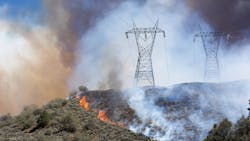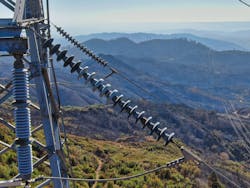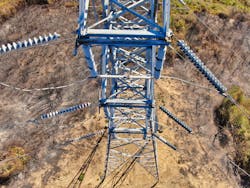How To Select Pole Material With Wildfires In Mind
In general, utility poles are made of four primary materials: wood, metal, fiberglass and concrete. Unfortunately, there is no one-size-fits-all solution, and the best option depends largely on a utility’s location, design criteria and state of existing systems. To get a better understanding of where these materials work best, Xcel Energy Inc., Snohomish County Public Utility District (PUD) and San Diego Gas & Electric Co. (SDG&E) share insights on fire hardening and their wildfire protection plans.
Xcel Energy
Xcel Energy services many U.S. states, but generally only experiences wildfires in Colorado, said David Flaten, senior distribution engineer at Xcel. In 2021, the utility estimated around 3000 line miles (4828 line km), or 70,000 individual poles, were vulnerable because of their location in wildfire zones. Because of the extra costs of switching to new poles, Xcel continues to use wooden poles, usually southern pine or cedar, in these areas. By covering the wood in fireproof wraps and fire-resistant coatings instead of replacing them, Xcel can harden line miles faster and with lower cost.
Damaged wooden poles are more vulnerable to fire than solid ones, and lamination provides them with an extra barrier of protection. Xcel’s network of wooden utility poles is extensive, and because of this, they are doing all they can to harden their existing wooden structures against fire.
Snohomish PUD
Snohomish PUD, on the other hand, prefers all metal structures, said Gordon Hayslip, the utility’s senior manager of transmission engineering and standards. Located in Washington state, wildfires are not typically on the radar for this public utility. However, because of climate change, recent fires have been creeping closer and the utility wants to proactively solidify its wildfire plan before fires become a big problem.
“It is expensive to replace a transmission pole, but it’s such a critical asset the incremental cost of going to a non-wood pole is really minor,” Hayslip said.
As Snohomish learned, if poles are regularly subjected to damaging forces, whether that be the beak of a woodpecker or the bite of a flame, then it makes a lot of sense to invest in something sturdier so they don’t have to be replaced as often.
The utility tried several non-wood options before arriving at ductile iron. For a while, it used spun concrete poles, courtesy of a local manufacturer. However, because of the weight of the material, this option often is not feasible unless provided by a local supplier. Since transportation and installation of the heavy material is more complicated, Snohomish PUD discontinued this practice in favor of lighter metal structures.
“It has been our experience in wood pole class equivalents that ductile iron is much more cost competitive than classic steel,” Hayslip said. “In some cases, we found that the price of ductile iron is almost the same as wood when you’re getting into 75- to 80-ft [23- to 24-m] H4 or better pole sizes. There’s really almost no cost adder to go with ductile iron.”
Since going with metal poles, Snohomish PUD also has noticed a variety of side benefits of the material. In the event of a phase contact with the arm, because of something like an insulator break or a loose tie, a conductive pole will trigger upstream protection devices much more quickly than a wooden pole, which may burn and allow wires to fall to the ground. With metal, the utility also does not have to worry about grounds being stolen by copper thieves since the pole itself is the ground.
Snohomish PUD hopes that by integrating metal poles into its system, it can create a pole line with a life span of 70 years to 80 years.
SDG&E
SDG&E also prefers metal structures, said Christian Henderson, electric distribution engineering manager at SDG&E. In 2021, the utility estimated it had around 54,000 circuit miles (86,905 circuit km), or 80,000 distribution poles, in what it refers to as high fire threat districts. After enduring some devastating fire damage in 2007 and 2008, wildfire mitigation has become one of its top priorities.
“We transformed from wood to steel,” Henderson noted. “We have a requirement now in our high fire threat districts for either steel or fiberglass.”
Steel structures usually are SDG&E’s first choice, but the conditions do not always allow for it. In known corrosion areas or challenging environments such as wetlands, the utility will often use fiberglass instead. However, fiberglass poles come with their own set of challenges. For instance, fiberglass is not very rigid and can have some issues regarding deflection.
To avoid unforeseen damage, SDG&E often sizes fiberglass poles slightly larger than normal, and the utility is always mindful of the type of loading and stress the poles will have to endure. It has even built multiple weather stations to assess the wind strain on its poles and account for actual conditions during design, so it can engineer systems that are less likely to fail.
According to Henderson, fiberglass poles also are challenging because “the tools you need to work with a fiberglass pole are considerably different than the tools you need to work with a ductile iron or a steel pole.”
This means that crews who are new to fiberglass will need to be retrained and familiarized with the new equipment, which takes time.
Be Proactive
Wildfires are a recurring threat for utilities in at-risk regions. Being proactive about wildfire mitigation now can end up saving utilities money in the long run. It is time for all electric utilities to start thinking about their wildfire plan and which pole materials will work best for them.
Editor’s note: For more information on what to consider during pole material selection, such as how to involve stakeholders, watch the webinar on Pole Material Selection for Fire-Prone Systems: Wood, Fiberglass, Metal, or Concrete.
Brad Hennessey is a senior project engineer and business unit director at POWER Engineers. He specializes in underground and overhead transmission and distribution systems and currently oversees POWER’s 400+ professionals dedicated to distribution engineering and design across North America. Brad holds a bachelor’s degree in electrical engineering from Montana State University and a master’s degree in engineering management from the University of Colorado. He is also a licensed electrical engineer in Arizona, California, Idaho, Washington, Oregon and Texas.
Megan Happel is a content developer, writer and editor for POWER Engineers. She specializes in transforming complex engineering projects into concise, relevant content for a wide variety of audiences and channels. She holds both a bachelor’s degree in engineering management and a bachelor’s degree in scientific and technical communication from Michigan Technological University.
About the Author
Brad Hennessey
Brad Hennessey, P.E. is a senior project engineer and business unit director at POWER Engineers. He specializes in underground and overhead transmission and distribution systems and currently oversees POWER’s 400+ professionals dedicated to distribution engineering and design across North America. Brad holds a bachelor’s degree in electrical engineering from Montana State University and a master’s degree in engineering management from the University of Colorado. He is also a licensed electrical engineer in Arizona, California, Idaho, Washington, Oregon and Texas.
Megan Happel
Megan Happel is a content developer, writer and editor for POWER Engineers. She specializes in transforming complex engineering projects into concise, relevant content for a wide variety of audiences and channels. She holds both a bachelor’s degree in engineering management and a bachelor’s degree in scientific and technical communication from Michigan Technological University.


